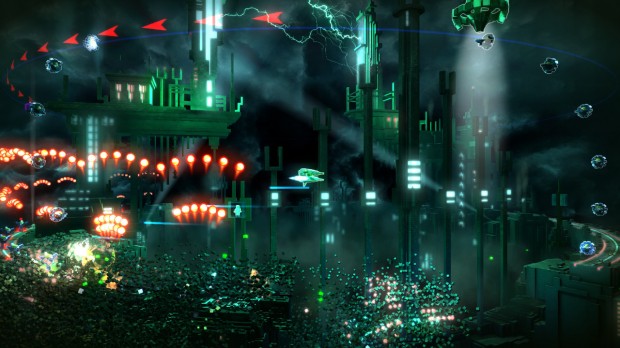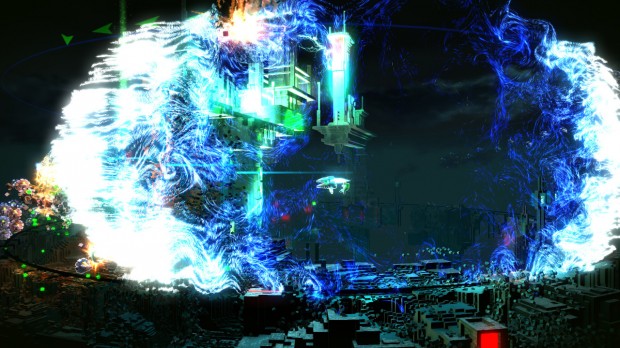Resogun’s Harry Kruger: “Explosions pretty much constantly”
- Updated: 2nd Sep, 2013
 I’ve been a huge fan of Finnish game developers Housemarque since the early 1990s when they first released their awesome Amiga games Stardust and Super Stardust. After dabbling with some of the more exotic platforms including the Gizmondo and N-Gage. they released the beautiful Super Stardust HD on PlayStation 3 in 2007. With tough top-down shooter Dead Nation and Super Stardust Delta on PS Vita, Housemarque’s games have always had a lovely retro feel about them.
I’ve been a huge fan of Finnish game developers Housemarque since the early 1990s when they first released their awesome Amiga games Stardust and Super Stardust. After dabbling with some of the more exotic platforms including the Gizmondo and N-Gage. they released the beautiful Super Stardust HD on PlayStation 3 in 2007. With tough top-down shooter Dead Nation and Super Stardust Delta on PS Vita, Housemarque’s games have always had a lovely retro feel about them.
At gamescom 2013 I chatted with Harry Kruger, lead programmer on Resogun, Housemarque’s latest game and a PlayStation 4 launch title. In this first part of our interview we talk about Housemarque’s inspiration for the game, end of level bosses and PlayStation 4 share clips.
After first seeing it at Sony’s gamescom press briefing, Resogun looked like it was a cylindrical version of Super Stardust HD.
Harry Kruger: Well, in Super Stardust the game was wrapped around a sphere but with Resogun we decided to do something a bit different and went with a cylinder instead. Other than simply looking cooler it has gameplay implications as well because you get a really clear spacial awareness of your surroundings and your environment and the threats therein. You can literally see around the bend and see the threats approaching.
What’s been your inspiration for Resogun?
HK: In many ways you can say this game is to Defender and Datastorm on the Amiga what Super Stardust HD was to Asteroids. We like the horizontal shooting parts of Defender and I’ll use Datastrom as the reference here, we like the extra layer of gameplay that came with the humans that you need to learn over time to build up your score and get the most out of the game. Harri Tikkanen, our creative director, was the one who came up with the idea of a cylindrical world. The game is decidedly retro in many ways – just like some of our other titles – and we wanted to go with a visual style that represents that. It’s neo-retro, I guess.
How are the levels constructed? When you look closely you can see that that it’s all tiny cubes?
HK: Everything in the game is comprised of these voxels that are building blocks of the Resogun universe, so to speak. The individual cubes are exported as a 3D texture and then polygonised on the fly. Every time an explosion happens, the geometry for that section of the level is recalculated. That’s all done on the GPU side so it’s pretty performance friendly.
A lot of the work done by the PS4s GPU then?
HK: A lot the stuff has actually moved to compute shaders; for example, lots of particle effects. When you activate the overdrive beam or the smartbomb you see lots of these particles come out. All those are updated on the GPU and all of the physical cubes that you see bouncing around, of which we can have up to 200,000 currently. All have full collisions, their own lighting and everything. Nothing is being faked here with point sprites, it’s all actually physical 3D cubes that are bouncing and interacting with the world in real-time. You can see as the cubes are bouncing around and if you boost through them they will react to you.
This is mostly what we’ve done with previous games as well, really simple pick-up-and-play mechanics with simple controls and lots of explosions and particle effects. Now with the power of the PS4 we’ve been able to take this to the next level and crank it up to the max.
In this demo level, when you defeat the huge boss the whole level disintegrates. Is that going to happen in the full game too?
HK: That’s the plan. It’s the reward you get for killing the boss in each level. You get to see the level destroyed.
What are the ideas behind the end of level bosses? Are you just making them as big as possible?
HK: For this boss [gamescom demo level] we went for size as one of its defining factors. A couple of other bosses we’ve been playing around with are also pretty big so I guess that maybe is the theme!
The scale works really well in this game, even the height of the cylinder. The actual gameplay area increases and we achieve a nice sense of scale. If you fly around the other side of the cylinder you can see it [the boss] coming around the bend. It looks great.

Because you can see things coming from afar, are you trying to intimidate the player?
HK: Yeah, well, it’s extra information for the player. The main difference between this and traditional side-scrolling shooters is that on top of the immediate gameplay layer you also have clear visibility of the rest of the gameplay area as well. Other games had to use a minimap to do that even though technically it was a cylindrical play field, like Defender or Datastorm. As you were going around in circles it was looping. Here we can map the game to an actual cylinder so the looping comes naturally from that.
One thing that worries me about the PS4s share button is people uploading hundreds of very similar clips. Have you been focusing on giving Resogun the potential to have crazy share clips?
HK: We are looking forward to seeing all the clips that are going to be taken out of this game. There are explosions pretty much constantly but even then we have highlights. We have moments where things really hit the fan and it gets absolutely insane.
The level being shown [at gamescom] isn’t even the most intense that you will experience in the final game. It’s about 30-40% of the highest difficultly. There’s going to be lots more enemies, lots more explosions, lots more stuff flying around. It’s going to be running at an uncompromising 60 frames per second (FPS) so you’ll be able to see all of those explosions in their full HD glory without dropping a beat.
Thanks for your time.
Look out for part 2 of this interview coming tomorrow. Kruger talks about some of Resogun’s in-game and online features, and throwing humans around.
Resogun will be a PlayStation 4 launch title and also free to PS+ subscribers.

Follow Us!